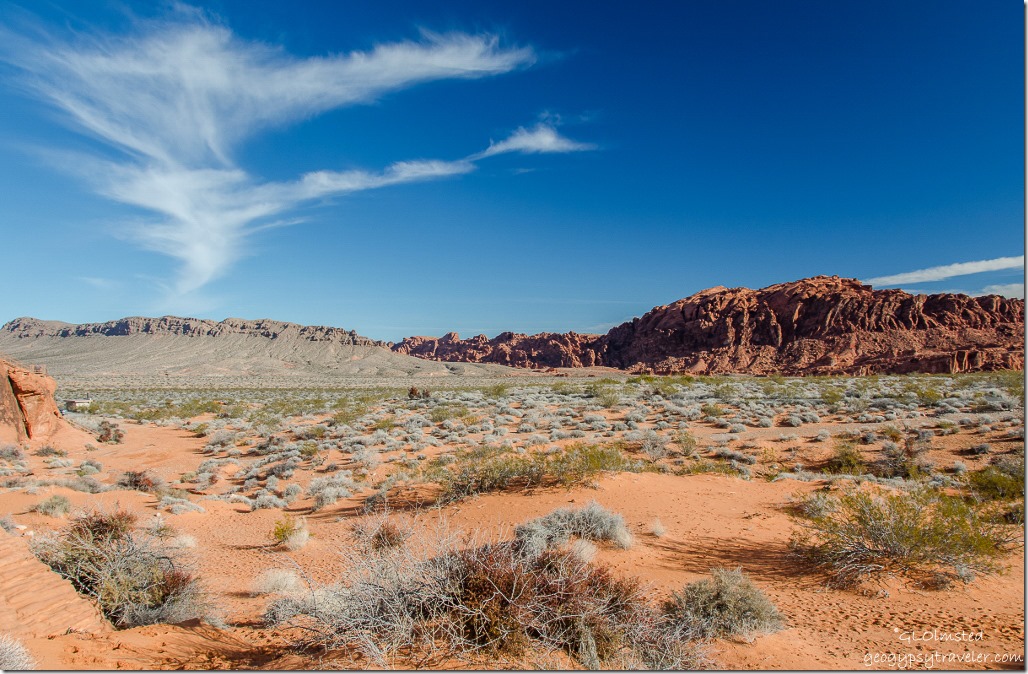 The day after hiking the White Domes loop and Fire Wave trails at Valley of Fire we started the morning with a short walk from camp to see the 4,000 year-old petroglyphs at Atlatl Rock. A big landscape spreads out from the rock cliffs where the petroglyphs are prevalent.
The day after hiking the White Domes loop and Fire Wave trails at Valley of Fire we started the morning with a short walk from camp to see the 4,000 year-old petroglyphs at Atlatl Rock. A big landscape spreads out from the rock cliffs where the petroglyphs are prevalent.
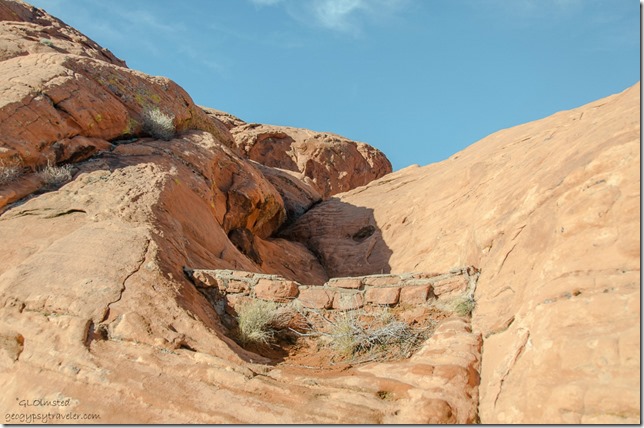 I’d read to look in a tiny side canyon littered with boulders just to the left of the actual “feature”. So off we went to explore. First we saw what looked like an improved check dam once built to hold back water in a natural dip, or tank, in the rocks. Of course we had to climb up about 10 feet to discover water, a rare and exciting find in this dry environment. We saw another shrinking pool hidden behind the cliffs.
I’d read to look in a tiny side canyon littered with boulders just to the left of the actual “feature”. So off we went to explore. First we saw what looked like an improved check dam once built to hold back water in a natural dip, or tank, in the rocks. Of course we had to climb up about 10 feet to discover water, a rare and exciting find in this dry environment. We saw another shrinking pool hidden behind the cliffs.
I took hundreds of photos so will try not to share them all. Yet I am fascinated by the stories told here so long ago. The earliest people here included the nomadic Fremont and later the Ancestral Puebloan farmers from the nearby Moapa Valley who came here to hunt and gather plants. Yet the scarcity of water probably limited their stay.
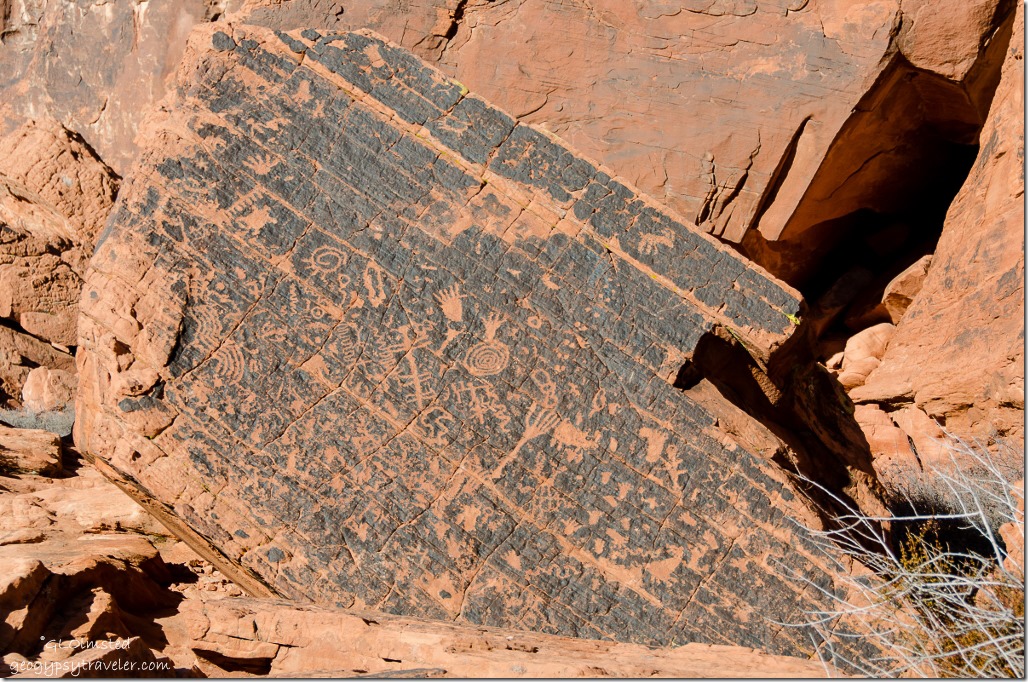 Some boulders have fallen from the cliff faces as parts of the story are buried in the sand where they landed. Seeing footprints in a row makes me think someone took a journey. I think I see water signs, dragonfly and yucca plant. It’s a busy panel. What story do you see.
Some boulders have fallen from the cliff faces as parts of the story are buried in the sand where they landed. Seeing footprints in a row makes me think someone took a journey. I think I see water signs, dragonfly and yucca plant. It’s a busy panel. What story do you see.
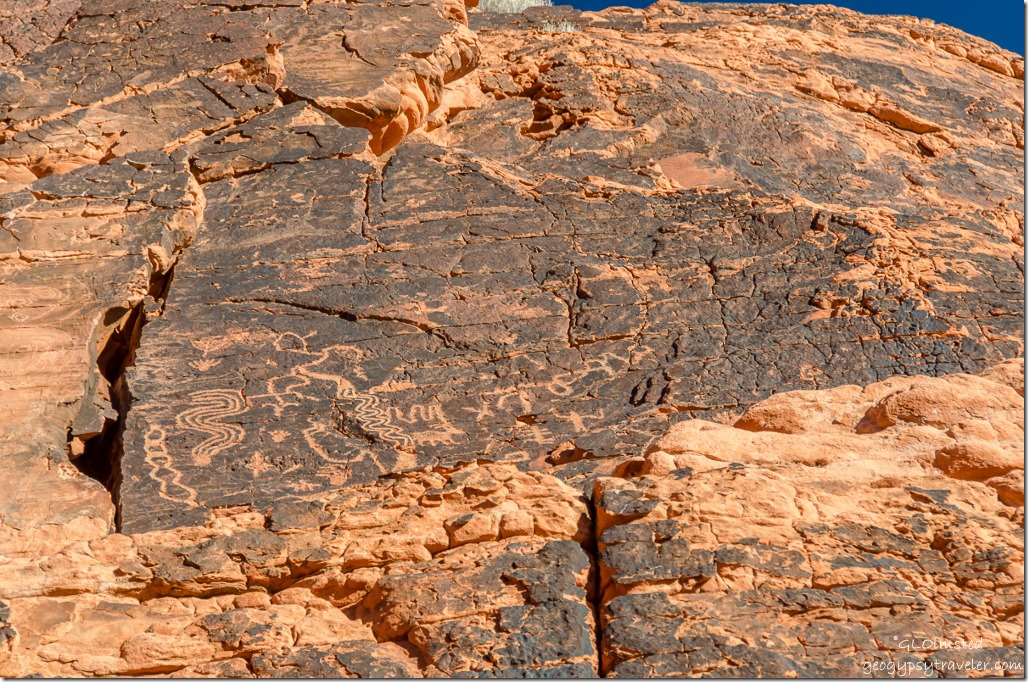 Some panels are way up high making me wonder why there, although there is usually a ledge or sloped face making it possible for these expert rock climbers to reach their pallet.
Some panels are way up high making me wonder why there, although there is usually a ledge or sloped face making it possible for these expert rock climbers to reach their pallet.
Plus of course there’s natures art as well where spalling and mineral leaching creates interesting patterns.
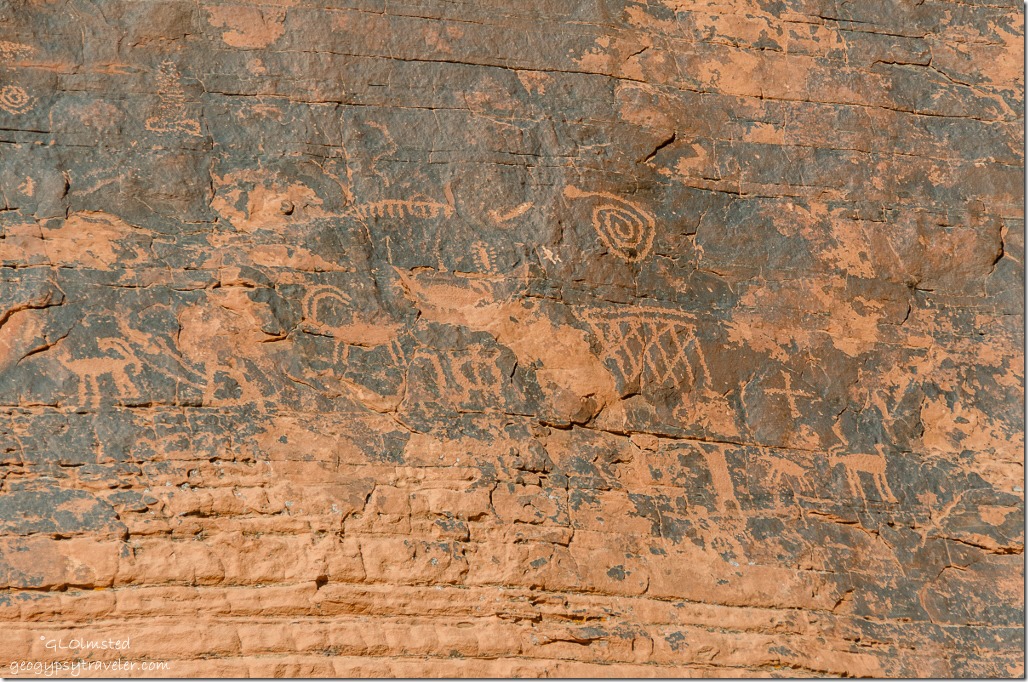 In fact natural processes have removed the mineral varnish and taken away some of the petroglyphs so some of the story is missing.
In fact natural processes have removed the mineral varnish and taken away some of the petroglyphs so some of the story is missing.
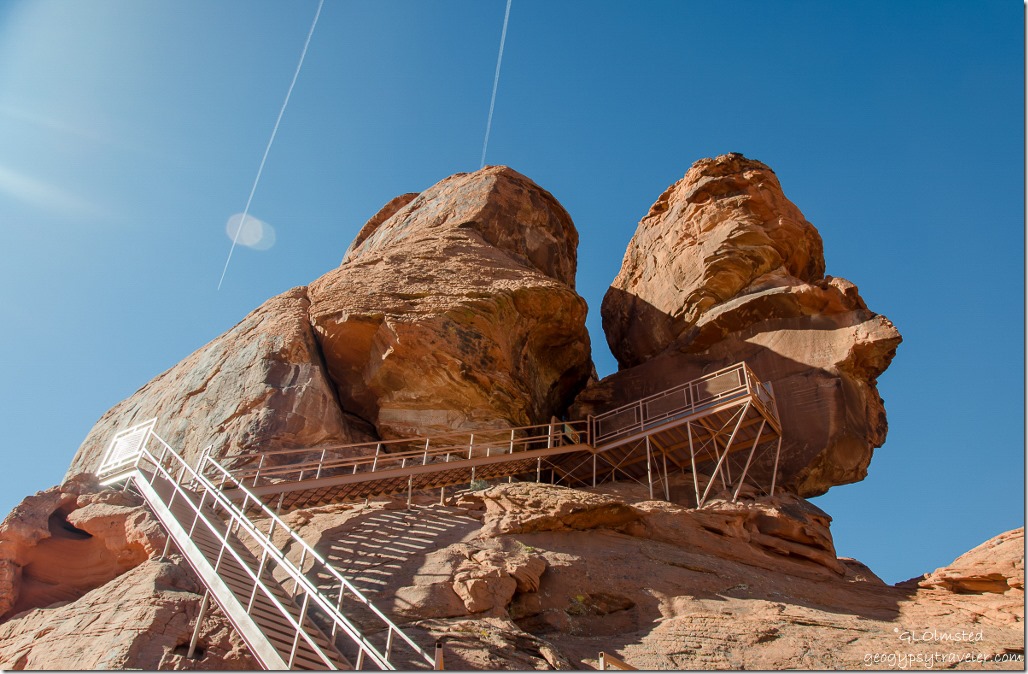
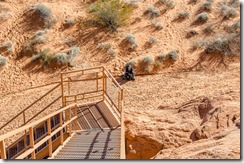 To access the “featured” and unique atlatl petroglyph requires climbing a steep set of stairs put in I’m sure to keep people off the rock and destroying the multiple panels. In fact the barrier at the top makes it difficult to photograph the entire panel. The grid on the stairs isn’t particularly dog friendly, or Sasha friendly anyway, but we did see a guy descending with his dog. I’ve never seen an atlatl petroglyph before.
To access the “featured” and unique atlatl petroglyph requires climbing a steep set of stairs put in I’m sure to keep people off the rock and destroying the multiple panels. In fact the barrier at the top makes it difficult to photograph the entire panel. The grid on the stairs isn’t particularly dog friendly, or Sasha friendly anyway, but we did see a guy descending with his dog. I’ve never seen an atlatl petroglyph before.
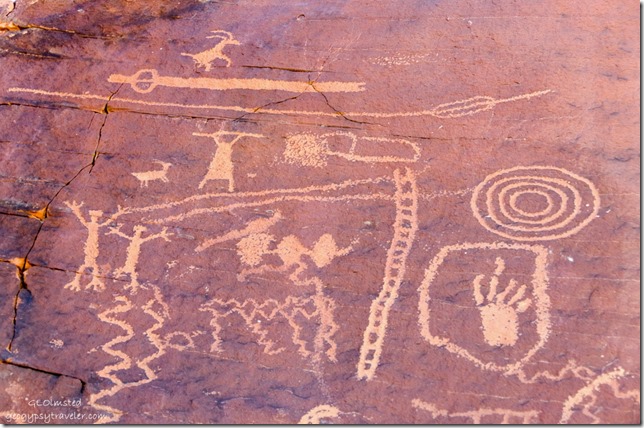 The second figure from the top under the big-horn sheep is suppose to be an atlatl which is a spear thrower used before the bow and arrow for hunting by native people. Do you think they climbed a ladder to this particular rock? It is unfortunate that modern people felt the need to add to these mysterious stories.
The second figure from the top under the big-horn sheep is suppose to be an atlatl which is a spear thrower used before the bow and arrow for hunting by native people. Do you think they climbed a ladder to this particular rock? It is unfortunate that modern people felt the need to add to these mysterious stories.
 Archeologists try to figure out what the petroglyphs mean. Row 1 left to right: Tortoise/turtle clan, Big-horn sheep, personal signature/death, Shaman/strong medicine/powerful. Row 2: general upward motion, sun, mystical bat woman, going up/water tank/spring. Row 3: broad downward motion, gone/empty, four directions/crossing, coming down. Row 4: rain, (can’t read), atlatl, four directions/friendship.
Archeologists try to figure out what the petroglyphs mean. Row 1 left to right: Tortoise/turtle clan, Big-horn sheep, personal signature/death, Shaman/strong medicine/powerful. Row 2: general upward motion, sun, mystical bat woman, going up/water tank/spring. Row 3: broad downward motion, gone/empty, four directions/crossing, coming down. Row 4: rain, (can’t read), atlatl, four directions/friendship.
Next stop Mouse’s Tank hike where we’d see more petroglyphs.


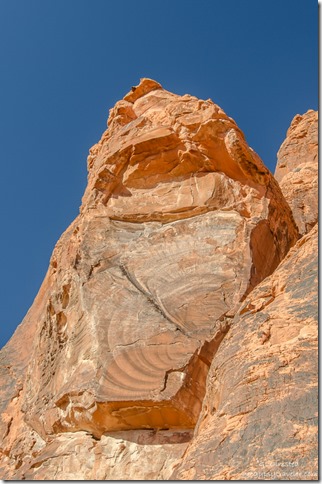
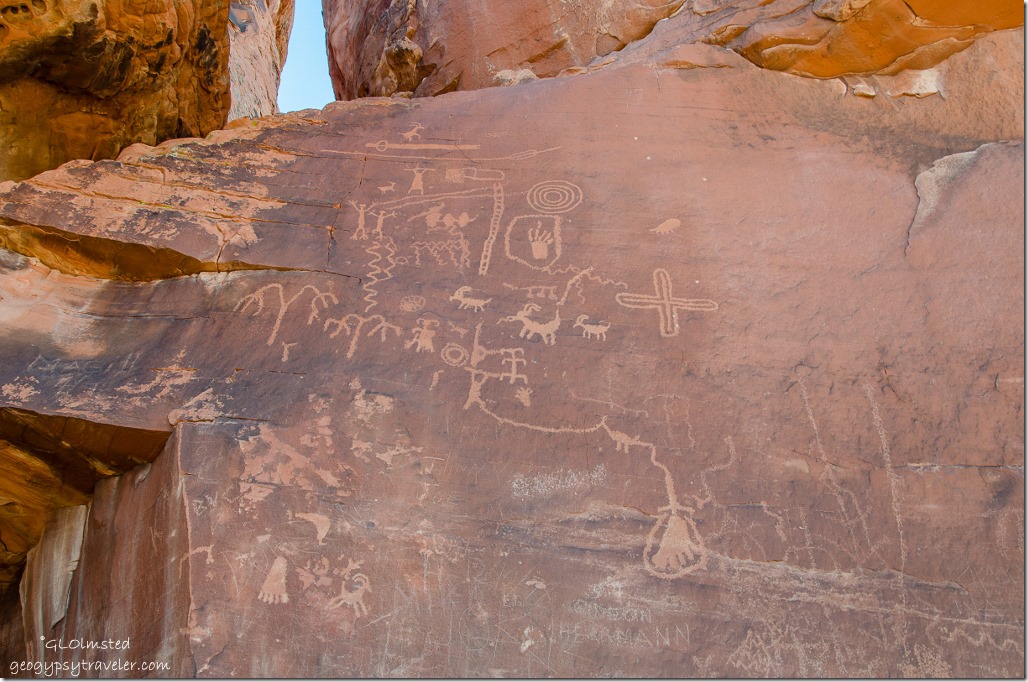
So fascinating. Thank you for taking such great photos to share these with us. I had no idea petroglyphs were so prevalent in the desert.
You’re welcome and thank you for coming along. There’s a lot of rock art in the desert SW.
Another neat area in Valley of Fire:) My husband and I feel that the petroglyphs are graffiti of the times and don’t necessarily stand for anything like our graffiti today. We have looked at the various locations of much of the drawing in our hikes and it makes sense to think that it was youth defacing the rock walls. Many of the pieces are high or in obscure locations. One of the many mysteries of the southwest:)
Most native people I’ve talked to say the rock art is story which is interpreted many ways. I like mysteries.
Wow what an interesting post, and I love that you have a sign giving some idea of what all the drawings mean. As in the bushman paintings if you look long enough you can make a real story from them all. It is sad that people nowadays think they can add to these stories, I will never understand why anyone should spoil natural history! Thanks for sharing Diane
I like to try and interpret the stories even if not the same as the original artist.
Love your interesting hiking posts, always some thing wonderful yo see.
Thanks. If you haven’t been to Valley of Fire I recommend putting it on the list.
This is fascinating Gaelyn. I just love pictographs and petroglyphs. Your pictures of the glyphs and the surroundings are wonderful. Like you, I always wonder what they are trying to say and why in the world anyone would want to deface them. It always makes me angry and ashamed of my fellow “modern humans”. Would you add your art to a Rembrandt if the museum guards weren’t watching? Can’t wait to go there and to see more of your upcoming visit.
Thank you Sherry. I don’t understand why people have to deface any art. Guess they’d be arrested for doing that in a museum. There’s more to come.
Atlatl rock is fascinating isn’t it? We spent ages making up different stories from the petroglyphs, but who knows. Enjoy Mouse’s Tank. Have Fun!
I too love to try and read the stories. Had never, knowingly, seen an atlatl petroglyph before. And there was so much more along the Mouse’s Tank trail.
Very intriguing. We’ll probably never figure out for sure what the petroglyphs are saying but they are very interesting to look at and ponder. I’m glad efforts are made to preserve them and mourn vandalism that destroy them.
I figure my interpretations are probably not correct but love the mystery. And hate the vandalism.
Hey Gaelyn ~
I’m just catching up on all of your posts, we’ve been on the road for a couple of weeks. Thanks so much for posting the chili relleano (sp) recipe, looking forward to trying it!
Petroglyphs are fascinating, aren’t they? Thinking about those who walked before us, the language they used/drew and the fact that they have lasted over centuries of time. Boggles the mind.
I’m looking forward to your posts about this most recent road trip. Think you’ll like the recipe. Most times when I’m in known native country I can almost feel a peaceful presence of the people from the past.
Boardwalks across swamps and grasslands, and stairs over the boulders – we are finally paying attention to how our numerous footsteps destroy what we step on. It gives me hope that our rate of destruction is finally slowing down 🙂 Love the rock art stories, whether they be silly tales or descriptive accounts, their history is wonderful. Thank you for sharing these with us!
I like the idea of staying off nature while still enjoying it.
So amazing! I’m glad the stairway is there. (it might not be too ‘old-lady’ friendly either, but I’d sure try it if I had a chance). Those are fabulous petroglyphs.
One step at a time. 😉